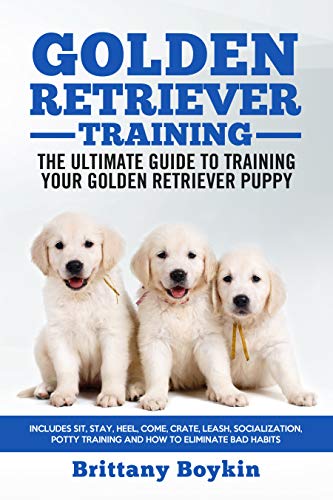Training your Golden Retriever requires patience and consistency. Establishing a routine early helps in building good behavior.
Golden Retrievers are intelligent and eager to please, making them highly trainable. Start with basic commands like sit, stay, and come. Positive reinforcement techniques, such as treats and praise, work best for this breed. Consistent training sessions, ideally short and frequent, prevent boredom and keep your dog engaged.
Socialization is equally crucial; expose your Golden Retriever to various environments, people, and other animals to foster a well-rounded temperament. Incorporating playtime and exercise helps in maintaining their physical and mental health. With the right approach, training your Golden Retriever can be a rewarding experience for both you and your furry friend.

Credit: www.walmart.com
Introduction To Golden Retriever Training
Training a Golden Retriever is a rewarding experience. These dogs are known for their intelligence and friendly nature. Proper training helps them become well-behaved family members. This guide covers the basics of training your Golden Retriever.
Why Train Your Golden Retriever?
Training is essential for every dog. It ensures they know how to behave in different situations. Here are some key reasons why training your Golden Retriever is important:
- Safety: A trained dog is less likely to get into dangerous situations.
- Bonding: Training strengthens the bond between you and your dog.
- Socialization: A well-trained dog interacts better with people and other dogs.
- Mental Stimulation: Training keeps your dog’s mind active and sharp.
Setting Expectations Early
Start training your Golden Retriever as soon as you bring them home. Puppies are like sponges. They learn quickly at a young age. Here are some tips for setting expectations early:
- Consistency: Use the same commands and rewards every time.
- Patience: Training takes time. Be patient with your puppy.
- Positive Reinforcement: Reward good behavior with treats and praise.
- Short Sessions: Keep training sessions short and fun.
By setting expectations early, you help your Golden Retriever understand what is expected of them.

Credit: www.amazon.com
Essential Supplies For Training
Training your Golden Retriever can be a rewarding experience. To achieve the best results, you need the right supplies. This section covers the essential items you need for training your furry friend.
Choosing The Right Leash And Collar
The leash and collar are crucial for effective training. They help you control your Golden Retriever. Choose a durable leash that is easy to handle. A 6-foot leash is ideal for most training exercises. It provides enough control without restricting movement.
For the collar, there are several options:
- Flat collar: Suitable for everyday use
- Martingale collar: Provides extra control without choking
- Head collar: Helps with pulling and jumping issues
Treats And Reward Systems
Using treats is a powerful way to reward your dog. Choose high-quality treats that your Golden Retriever loves. Soft treats are usually the best. They are easy to chew and consume quickly.
Establish a reward system to reinforce good behavior. Here are some tips:
- Use small, bite-sized treats.
- Reward immediately after a desired behavior.
- Be consistent with the rewards.
Avoid giving too many treats to prevent weight gain. Balance treats with praise and affection. This combination will make your Golden Retriever eager to learn and obey.
| Supply | Why It’s Important |
|---|---|
| Leash | Provides control and safety during walks |
| Collar | Holds identification and helps with control |
| Treats | Rewards good behavior and motivates training |
Basic Commands Every Golden Should Know
Training your Golden Retriever requires patience and consistency. Basic commands are essential for good behavior and safety. Here are the basic commands every Golden should know:
Sit
The Sit command is fundamental. It helps control your dog in various situations.
- Hold a treat close to your dog’s nose.
- Move your hand up, allowing their head to follow the treat.
- As the head goes up, the bottom will lower.
- Once in a sitting position, say “Sit” and give the treat.
Stay And Come
Stay and Come commands are crucial for keeping your dog safe.
Stay
- Ask your dog to sit.
- Open your palm in front of you and say “Stay”.
- Take a few steps back.
- If they stay, reward them with a treat.
- Gradually increase the distance over time.
Come
- Attach a leash to your dog’s collar.
- Say “Come” and gently pull the leash towards you.
- Reward with a treat when they come to you.
Heel And No
The Heel and No commands help manage your dog’s behavior during walks and at home.
Heel
- Start with your dog sitting by your left side.
- Hold a treat in your left hand.
- Say “Heel” and start walking.
- If your dog stays by your side, reward them.
- Practice this regularly for better control during walks.
No
- Use a firm voice to say “No” when your dog misbehaves.
- Redirect their attention to a positive activity.
- Reward them when they follow the correct behavior.
House Training Your Golden Retriever
House training your Golden Retriever is essential for a happy home. It takes patience, consistency, and a little know-how. In this section, we’ll cover the basics to get you started. You’ll learn how to establish a routine and handle accidents effectively.
Establishing A Routine
Routines are crucial for house training. Start by taking your puppy outside first thing in the morning. Follow this with trips after meals, naps, and playtime. A regular schedule helps your Golden Retriever understand when and where to go.
Keep track of feeding times. This helps predict when your puppy will need to go. Maintain a feeding schedule with set times each day.
| Time | Activity |
|---|---|
| 7:00 AM | First trip outside |
| 8:00 AM | Breakfast |
| 9:00 AM | Post-meal bathroom break |
Socializing Your Dog
Socializing your Golden Retriever is crucial for their well-being. This part of their training ensures they grow up friendly and confident. Proper socialization helps prevent behavioral problems and makes them happier pets.
Importance Of Early Socialization
Early socialization is vital for Golden Retrievers. During the first few months, puppies are curious and open to new experiences. Exposing them to different sights, sounds, and people during this period helps them adapt better.
Key benefits of early socialization:
- Reduces fear and anxiety.
- Prevents aggressive behavior.
- Encourages positive interactions with other animals.
Safe And Effective Socialization Practices
Ensuring your Golden Retriever’s socialization is safe and positive is essential. Always supervise interactions and start with controlled environments.
Effective practices include:
- Introduce your puppy to different environments like parks and busy streets.
- Arrange playdates with friendly, vaccinated dogs.
- Expose them to various sounds such as vacuum cleaners, doorbells, and traffic.
- Meet different people with varying appearances and ages.
- Enroll in a puppy training class for guided socialization.
| Age | Socialization Activities |
|---|---|
| 8-12 weeks | Introduce to family, car rides, and household noises. |
| 12-16 weeks | Walks in the neighborhood, meeting other dogs. |
| 4-6 months | Visits to the vet, grooming sessions, public places. |

Credit: www.amazon.com
Advanced Training Techniques
Golden Retrievers are smart dogs. They learn quickly with the right techniques. Advanced training can make them even better. These techniques help your dog perform complex tasks. Let’s explore some advanced methods.
Clicker Training
Clicker training uses a small device that makes a sound. This sound marks the desired behavior. It’s a type of positive reinforcement. Here’s how to start:
- Get a clicker and some treats.
- Click the device, then give a treat.
- Repeat this several times.
- Now, issue a command like “sit”.
- When your dog sits, click and treat.
Clicker training is effective. It helps your dog understand exactly what you want. Always click at the exact moment your dog performs the behavior.
Distance Commands
Distance commands teach your dog to obey from far away. This skill is useful in many situations. Start with simple commands:
- Begin with “sit” or “stay”.
- Stand a few feet away from your dog.
- Give the command clearly.
- Reward your dog if it follows the command.
- Gradually increase the distance.
Practice these commands in different settings. This helps your dog obey in any environment. Consistency is key. Always reward your dog for obeying.
Advanced training can strengthen your bond with your Golden Retriever. These techniques make your dog well-behaved and happy. Keep training sessions short and fun.
Troubleshooting Common Behavioral Issues
Even the most well-behaved Golden Retrievers can show behavioral issues. Understanding and addressing these can make training smoother. In this section, we’ll discuss some common problems and how to solve them.
Jumping On People
Jumping is a common problem for Golden Retrievers. They do this to show excitement or seek attention. To stop this behavior, follow these steps:
- Ignore the jumping: Turn away and avoid eye contact when they jump.
- Reward good behavior: Praise and treat them when they sit calmly.
- Teach the “sit” command: Make them sit before greeting people.
Excessive Barking
Excessive barking can be annoying and disruptive. It often happens due to boredom, anxiety, or attention-seeking. Here are ways to manage it:
- Identify the cause: Observe when and why they bark.
- Provide mental stimulation: Use toys and games to keep them engaged.
- Teach the “quiet” command: Reward them for being quiet on command.
In some cases, a consistent routine can help. Ensure they get enough exercise and attention daily.
Health And Nutrition For Optimal Training
Ensuring your Golden Retriever is healthy is essential. Proper nutrition and exercise play a key role. A balanced diet influences behavior and energy levels. Exercise keeps your Golden calm and focused. Let’s dive into the details.
Diet’s Impact On Behavior
A balanced diet affects your Golden Retriever’s behavior. Feeding your dog the right nutrients is crucial. Here’s how:
- Protein: Supports muscle growth and energy levels.
- Fats: Provide essential fatty acids for brain function.
- Vitamins and Minerals: Strengthen immune system and bone health.
Consider these foods for a balanced diet:
| Food Type | Benefits |
|---|---|
| Lean Meats | High in protein for muscle growth |
| Fish | Rich in omega-3 fatty acids |
| Vegetables | Packed with vitamins and minerals |
| Whole Grains | Provide energy and fiber |
Avoid feeding your Golden Retriever processed foods. They can lead to hyperactivity and health problems. Stick to natural, high-quality ingredients.
Exercise: The Key To A Calm Golden
Exercise is vital for a calm Golden Retriever. Regular activity helps manage energy levels. It also reduces anxiety and stress.
Incorporate these exercises into your routine:
- Daily Walks: At least 30 minutes twice a day.
- Fetch: Great for physical and mental stimulation.
- Swimming: Low-impact exercise, perfect for joint health.
- Agility Training: Enhances coordination and focus.
Regular exercise improves obedience and behavior. It also strengthens your bond with your dog. Make exercise fun and varied to keep your Golden engaged.
Fun Activities To Enhance Training
Training your Golden Retriever can be a joy. Engaging activities make the process fun and effective. These activities keep your dog active and mentally stimulated. Below are some fun activities to enhance your Golden Retriever’s training.
Agility Courses
Agility courses are perfect for training and exercise. They help improve your dog’s coordination and speed.
- Tunnels: Encourage your dog to run through tunnels.
- Weave Poles: Teach your dog to weave between poles.
- Jumps: Set up low jumps for your dog to leap over.
- A-Frames: A-frames help build your dog’s climbing skills.
Agility training builds your dog’s confidence. It also strengthens your bond with your furry friend.
Fetch And Retrieve Games
Fetch and retrieve games are classic and effective. They are great for physical exercise and mental stimulation.
- Basic Fetch: Throw a ball and ask your dog to bring it back.
- Frisbee: Use a frisbee for a new challenge and more fun.
- Hide and Seek: Hide toys and ask your dog to find them.
These games teach your dog to follow commands. They also provide a great way to burn off energy.
| Activity | Benefits |
|---|---|
| Agility Courses | Improves coordination and speed |
| Fetch and Retrieve | Enhances physical and mental stimulation |
Building A Strong Bond Through Training
Building a strong bond with your Golden Retriever starts with training. Training creates trust and mutual understanding. It makes your dog happy and obedient. This guide helps you achieve that. Let’s dive into the essentials of training your furry friend.
Training As A Team
Training should be a team effort. You and your dog should work together. This strengthens your bond. Dogs are social animals. They enjoy being part of a team.
Positive reinforcement is key. Reward your dog for good behavior. Use treats, praise, or play. Avoid punishment. It can lead to fear and mistrust.
| Do | Don’t |
|---|---|
| Use treats and praise | Yell or hit |
| Be patient and consistent | Expect instant results |
| Practice daily | Skip training sessions |
Understanding Your Dog’s Language
Dogs communicate through body language. Understanding this is vital. It helps you respond correctly.
Look at your dog’s tail, ears, and posture. A wagging tail usually means happiness. Ears back can signal fear or submission. A tense body can mean stress.
- Tail wagging: Happy and excited
- Ears back: Fear or submission
- Tense body: Stress or aggression
Learning these signs builds trust. It makes training easier. Your dog feels understood and safe. This leads to a stronger bond.
Continued Education For Your Golden
Training your Golden Retriever is not a one-time task. It requires ongoing effort and dedication. Continued education helps keep your dog engaged and well-behaved. This section explores methods to keep training fresh and the benefits of joining dog training clubs.
Keeping Training Fresh
Dogs love new challenges. Keeping training sessions fresh can prevent boredom. Try mixing up the commands and activities. Use a variety of toys and treats to maintain interest.
- Introduce new tricks every few weeks
- Alternate between indoor and outdoor training
- Use puzzle toys to stimulate the mind
Short, frequent sessions work best. A 10-minute session twice a day can be more effective than a long session. Always end on a positive note with praise or a treat.
Joining Dog Training Clubs
Dog training clubs offer structured learning environments. They provide opportunities for socialization and advanced training. Joining a club can also keep you motivated.
| Benefits | Description |
|---|---|
| Socialization | Your Golden meets other dogs and people. |
| Advanced Skills | Learn complex commands and tricks. |
| Consistency | Regular classes keep training consistent. |
Look for clubs with experienced trainers. They should use positive reinforcement methods. Check reviews and ask for recommendations.
Being part of a dog training club can provide support and resources. It helps you stay committed to your Golden’s education.
Success Stories And Testimonials
Success stories and testimonials provide inspiration and proof of effective training. They highlight real-life experiences and celebrate the hard work and progress of Golden Retriever owners.
Real-life Transformations
Witnessing a Golden Retriever transform through training is incredible. Each dog’s journey is unique and inspiring. Here are some amazing stories:
| Owner | Dog Name | Transformation |
|---|---|---|
| John Doe | Buddy | From a shy puppy to a confident companion. |
| Jane Smith | Bella | Overcame leash aggression and now loves walks. |
| Emily Johnson | Max | Learned advanced tricks and became a therapy dog. |
Celebrating Milestones
Training a Golden Retriever involves many milestones. Each achievement, big or small, deserves recognition. Here are some milestone examples:
- First Command: Teaching “sit” and seeing your dog respond.
- Socialization: Successfully introducing your dog to new friends.
- Off-Leash Control: Your dog reliably returns when called.
Celebrating these milestones keeps motivation high. It also strengthens the bond between owner and dog.
Frequently Asked Questions
How Do I Start Training My Golden Retriever?
Begin with basic commands like sit and stay. Use positive reinforcement, such as treats and praise. Consistency is key.
What Age Should I Start Training?
Start training your Golden Retriever at 8 weeks old. Early training helps establish good habits and socialization skills.
How Long Should Training Sessions Be?
Keep training sessions short, around 10-15 minutes. Frequent, brief sessions are more effective than long ones.
Are Golden Retrievers Easy To Train?
Yes, Golden Retrievers are intelligent and eager to please. Their friendly nature makes them highly trainable with positive methods.
Conclusion
Training your Golden Retriever can be a rewarding journey. Consistency and positive reinforcement are key. With patience and dedication, you can nurture a well-behaved and happy dog. Apply these tips to foster a strong bond and ensure a fulfilling experience for both you and your furry friend.











